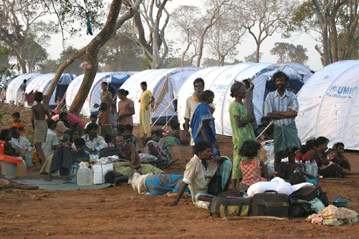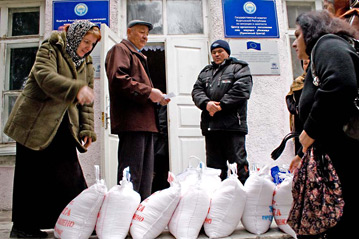Feature: The dye is cast as Barakwena women go home to Namibia
Feature: The dye is cast as Barakwena women go home to Namibia

GABORONE, Botswana (UNHCR) - Old habits dye hard for a group of Namibian refugee women in Botswana. But despite their withdrawn nature, the Barakwena women at Dukwi camp have tapped on their artistic heritage to become the best tie and dye group in the camp.
Now, as they prepare to bring their expertise home to Namibia's Caprivi region, community services officer Theresa Lisa Palmer looks back with a smile, "The Barakwena women in the tie and dye project have come so far."
The Barakwena, also called the San, are among the 2,500 Namibian refugees who fled to neighbouring Botswana between 1998 and 2000, fearing for their safety because of their alleged support for a secessionist movement in Namibia.
Historically a marginalised people, the Barakwena kept to themselves even in Dukwi camp. It has been through the gentle but persistent persuasion of the UN refugee agency and Palmer, a UN volunteer, that on the eve of their departure, many of their women have come out of their shell.
When Palmer first arrived at the camp in eastern Botswana, she was put in charge of all community activities, including the income-generating activities.
"Together with our implementing partners, we introduced several projects we had started with Liberian refugees in Sierra Leone. These are tie and dye, brick moulding, poultry and backyard gardening," she says. "We started the tie and dye with other refugee women, which is generally very fast to implement. The Barakwena, however, were very reluctant to join."
Lethlogile Lucas, Public Affairs Officer with the Botswana Christian Council, explains, "When Namibia gained independence, the Barakwena were generally not involved or brought into the mainstream of Namibian society, so they continued to be subjected and relegated to the periphery. They do not have the upper hand and are not in the leadership that left the Caprivi region at the height of political destabilisation in the area."
Cosmas Chanda, who heads UNHCR's liaison office in Botswana, agrees: "They are very seclusionist people who generally haven't been exposed to much education or modern living."
Palmer remembers being "shocked and distressed" at the rate at which the girls were having babies - some from the age of 11. In addition, because of their nomadic nature, many of the Barakwena did not adapt well to camp life. Some turned to drinking.
"This was a great concern for UNHCR and was one of the issues we wanted to address speedily," she says. "Compounding this was the fact that the first repatriation exercise was looming [in August 2002] and we all wanted to see them return home with an income-generating activity they could master quickly and that would work to their benefit at home."
Palmer convinced the Barakwena women to form their own group so that they could combine their skills and equipment to continue with the project when they returned home. She also tried to make their work environment as inviting and comfortable as possible.
"When assisting these women, a major mistake is to ask them to leave their children at home so that they can work easier," she says. "No matter how we preached about the dangers of paint fumes and ink chemicals to little children, they insisted on keeping their babies strapped to their backs. So we partitioned off a section of the room and got a few mattresses where the babies were kept under revolving supervision."
From then on, things ran very smoothly and the Barakwena women did very well.
"They actually turned out to be the best tie and dye group in the camp because historically, they are naturally gifted rock painters and artists," says Palmer. "The only problem was their inability to communicate, especially in English. Because of this, they had to engage with other Namibian refugees, who became their 'sales persons'. In this way, the barrier between them was broken."
The Barakwena women were invited to display and sell their wares at the International Trade Fair in Botswana's capital, Gaborone. They also took part in an exhibition organised by the Botswana Ministry of Women Affairs, which contributed 29,000 pula ($4,800) towards the tie and dye project to help the women get more materials and machines.
Five of them were sent on a basic business-training course run by Enterprise Botswana. They learnt how to run a business, keep the accounts, fix prices and basic book-keeping. With the rest of the group, they created a logo, printed letterheads and business cards and bought an invoice book to record their transactions.
To get the refugee women started on the tie and dye project, the UN refugee agency bought their start-up stock for about P100,000. Their initial profit was about P60,000, which they divided among themselves. Since then, they have continued buying and selling on their own, depositing their profits in the bank.
Besides teaching the Barakwena women marketable skills, UNHCR has also helped improve health care, especially among their children.
"Back in Namibia, they relied heavily on traditional medicines," says Chanda. "But at Dukwi, they are in a different environment and some of the herbs, tubers and roots they used to treat their children are not readily available here."
Palmer adds, "After trying all sorts of traditional medicines on a child who continued to be unresponsive to them, they would reluctantly approach the clinic. Of course, by that time it would be too late to save the child. For this reason, they thought taking their babies to the clinic killed them. But with increased exposure and interaction with others, they're starting to change their attitudes."
"We had to meet them halfway in assisting them, while giving them the room to be who they are. We encouraged medical staff to be proactive in providing preventive medicine," says Chanda, adding that the agency also established outreach networks and hired an additional doctor and two nurses to cope with the workload.
Through an under-five feeding scheme introduced by the government of Botswana, the women were also motivated to attend the clinic and family planning services. "In September alone, we had 18 births among the Barakwena. So we really are trying to educate them for the future as well," says Chanda.
Of the 2,300 Namibian refugees hosted at Dukwi, some 900 have already gone home under a voluntary repatriation programme run jointly by the governments of Botswana and Namibia and UNHCR. Return convoys are currently on hold till March 2003, partly due to the rainy season. The five-month break will allow time to prepare the final phase of returns and for students to complete their education at Dukwi. Refugees adopting a "wait and see" attitude will also have a chance to talk to recent returnees to help them decide whether or not to go home.
Before some of the Barakwena women left in late October, Palmer distributed bags, T-shirts and towels to them and shared a few words of encouragement and advice. It was a very poignant moment, as they knew they would probably never see each other again. The Barakwena women had, by this time, become very protective of her.

"Every time I left a cup of coffee unattended, the mug would be empty when I returned," recalls Palmer, eyes welling up with tears. "After several times, I asked them who was drinking my coffee. They told me that no one was. In their custom, unattended food or drink is an invitation to one's enemies to get up to mischief. They didn't want me to be bewitched! I was so bowled over by their concern."
"I'm telling you if there's anyone I'll miss in the camp, it will be the Barakwena tie and dye women!"
By Pumla Rulashe
UNHCR South Africa









